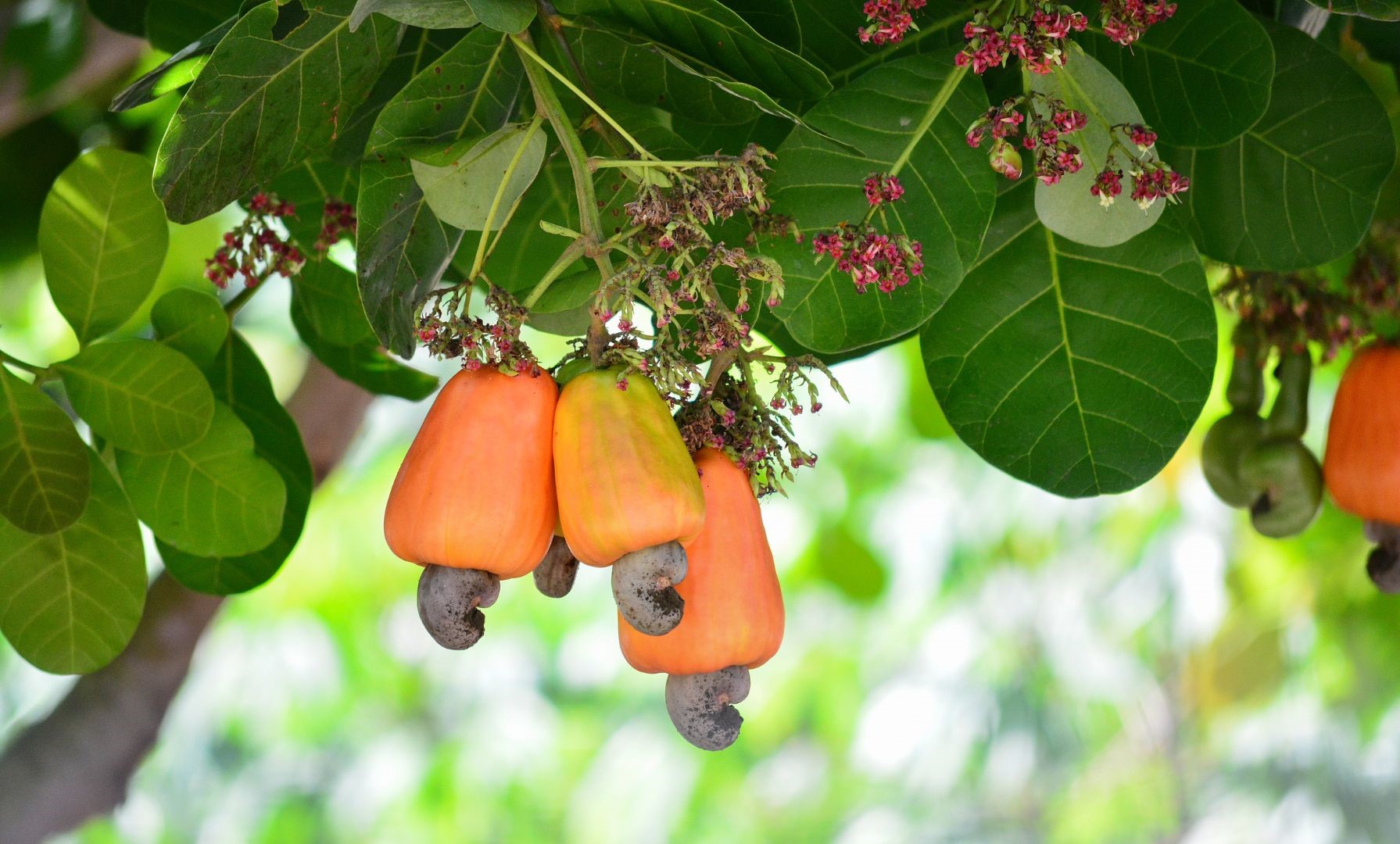Cashew: A high Profitability Versatile Crop – Best Practices, Uses and Market
At first glance, if held upside down, the cashew fruit (Anacardium occidentale) looks like an umbrella. The cashew apple, as it is popularly called, contains the juice – this juice is not sour or sweet, it is somewhere in between- it has a spicy taste if that adequately captures it. It is interesting to note that if this juice trickles onto your clothing, it will leave a permanent stain on it; similarly, if the liquid from the shell comes in contact with your skin – it could result in skin burn.
Yet, in recent times, there has been a buzz about cashews in both local and global markets. Why have farmers (conventional and organic ) suddenly decided to embrace cashew production and allocate more land to cultivating them? What do they know about cashews that leads them to take action to increase their yield?
The vibrant colors of the cashew fruit make it undeniably attractive. Some species are reddish-orange, and others yellow. Cashew apple juice has a high nutritional value, having six times more vitamin C than citrus (Bhat, 2008). However, the crop’s popularity lies in the many uses cashews can have. Cashews have been characterized as versatile fruits, with every part of the plant having important economic value.
According to research by Mordor Intelligence, the cashew nuts market size is estimated at US$7.82 billion in 2024 and is expected to reach US$9.20 billion by 2029. This is just for cashew nuts alone—it doesn’t include the estimates from the other cashew derivatives.
The most common derivatives of cashews are the:
- raw cashew nuts (RCN)
- cashew nut shell liquid (CNSL)
- cashew kernel (CK)
Some other derivatives include cashew juice, nut oil, shell powder, butter, flour, cashew nut peel (testa), and cashew wine.
More and more farmers are allocating substantial land to plant cashews in different parts of the world. This is the case with organic and conventional farmers, and rightfully so, too, as the demand for cashews continues to soar.
The farmers have at their disposal improved seedlings with good disease resistance and high yielding with a maturity period of between 18 months and 36 months. Unlike other cash crops like oil palm, rubber, and cocoa, this is a relatively short maturity period.
Best practices in cashew cultivation and production
For optimal results, cashew farmers must pay utmost attention to good agricultural practices in cultivating cashews for high yields and excellent quality. International markets are particularly demanding regarding the product’s quality parameters. Some of these practices include;
- Selecting an appropriate site for planting – well-drained, fertile soils with adequate exposure to sunlight.
- Selecting suitable varieties for planting, typically those that are high-yielding and disease-resistant
- Maintaining proper spacing between the trees—many farmers choose an 8m by 8m or a 7m by 9m distance. While the distances may look large, we need to keep in mind that the plants will grow relatively big (up to 14 m (46 feet)), and we need to give them enough space to avoid shadowing each other and overcrowding.

- Managing weeds, pests, and plant pathogens.
- Pruning diseased, dead, or crowded branches so that the plants can produce optimum yield. The trees should also be pruned in a way that sunlight can penetrate the canopies to encourage healthy growth.
- When harvesting cashews, it is important that the farmers do not shake the trees to avoid the fall of immature fruits, too. Immature nuts are a quality defect that decreases the overall quality of the raw cashew nut harvest/production. The nuts should be allowed to fall off the trees and picked up for further processing.
- Detaching the nuts from the plants should be done at the correct maturation stage (not earlier or later), and the harvested nuts should be sun-dried as soon as possible to avoid quality deterioration due to high moisture levels.
- Dried cashew nuts should be stored in Jute bags that allow good aeration, unlike polypropylene bags, which lead to quality deterioration. These bags should be stored on a pallet in a protected area until their sale to a local agent, merchant, exporter, or processor.
Important quality parameters of cashews
The primary quality parameters that raw cashew nuts are tested for are;
- The total number of defective nuts, which is made up of immature, void, rotten, spotted,
- Nut Count
- Moisture content (less than 10% and above 6%)
- Admixture
- Kernel Outturn Ratio (KOR) refers to the amount of usable kernels after de-shelling the raw cashew nuts
For cashew kernel (which is the extracted edible cashew nuts), the quality parameters are:
- Physical parameters, which cover grades and sizes of the nuts, Moisture content, foreign matter, defects, and uniformity of nuts
- Chemical parameters which include Aflatoxin levels, Free fatty acids, Foreign matter, Peroxide value, and Nutritional content
- Microbiological parameters such as yeast & mold count, pathogens, and total plate count
- Sensory parameters that include flavor & taste, texture, and visual appearance.
- Packaging parameters that cover shelf life (storability) and the integrity of the packaging.

Vietnam and India have long been recognized for their cashew processing capacity. They process raw cashew nuts into cashew kernel and cashew nut shell liquid for exports to Europe, the UK, the US, Canada, and Australia. Most of these raw cashew nuts come from African countries like the Ivory Coast, Ghana, Nigeria, Mozambique, Guinea Bissau,Tanzania, Benin, Burkina Faso, Senegal, and Kenya.
The processing of cashew nuts can be performed with the below-listed processing machinery:
- Cashew-size sorting machine
- Cashew shelling machine
- Cashew peeling machine
- Cashew steaming machine
- Cashew drying machine
- Cashew packing machine
- Cashew roasting machine
- Cashew nutshell liquid
Further reading
Cacao production: Challenges and Management Strategies
Sales, Trading, and Shipping Cocoa Beans
How Agricultural Marketing Cooperative Unions Strengthen Food Security for Smallholder Farmers
Empowering Oil Palm Farmers: Sustainable Solutions for Yield, Profitability, and Food Security












































































